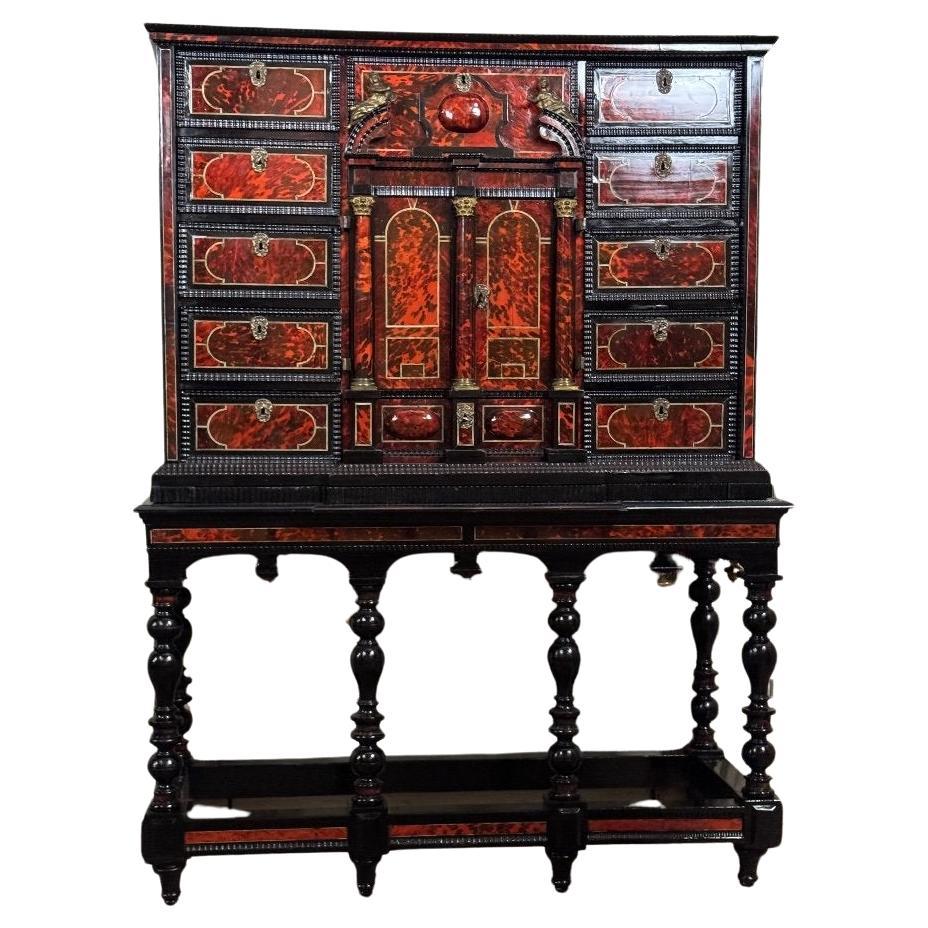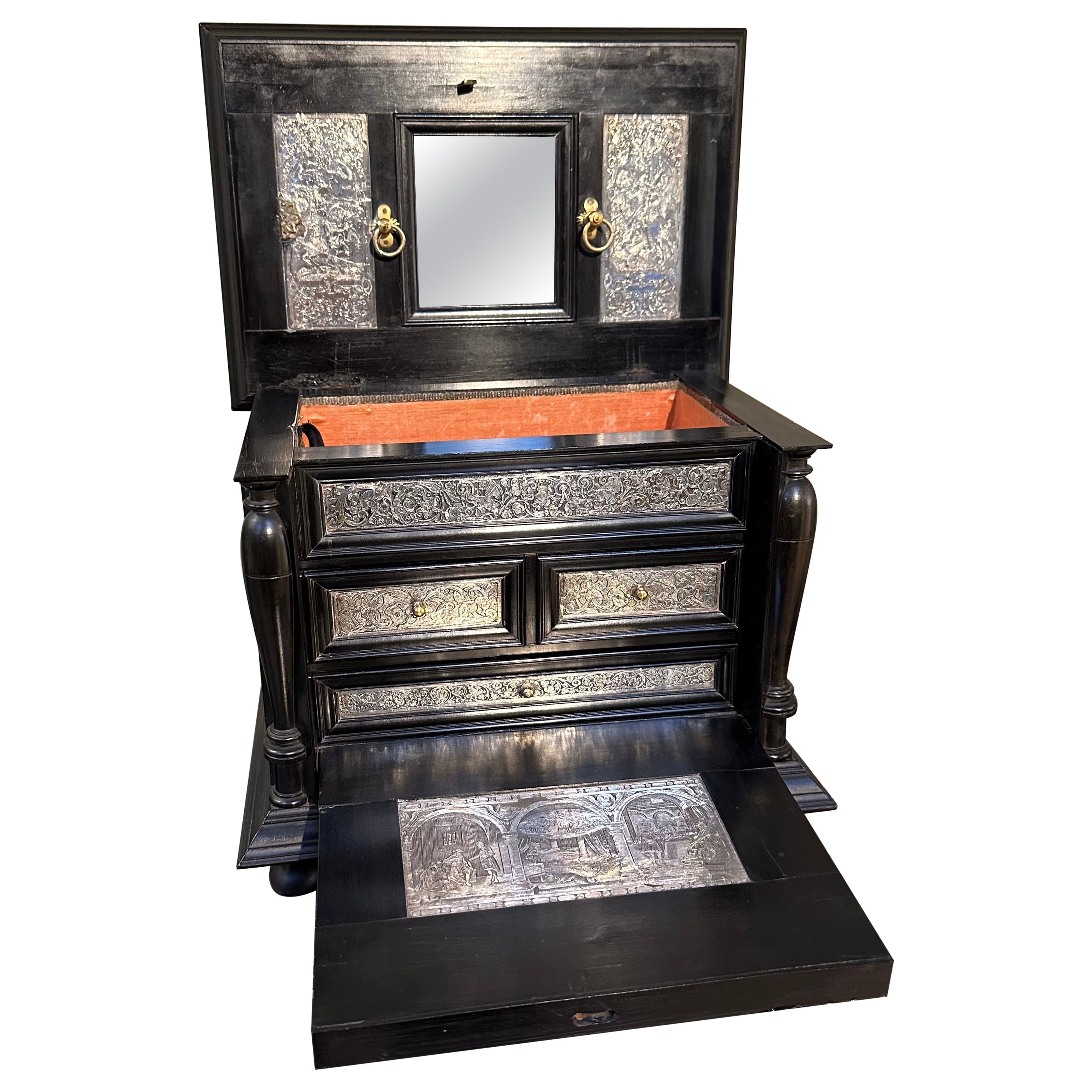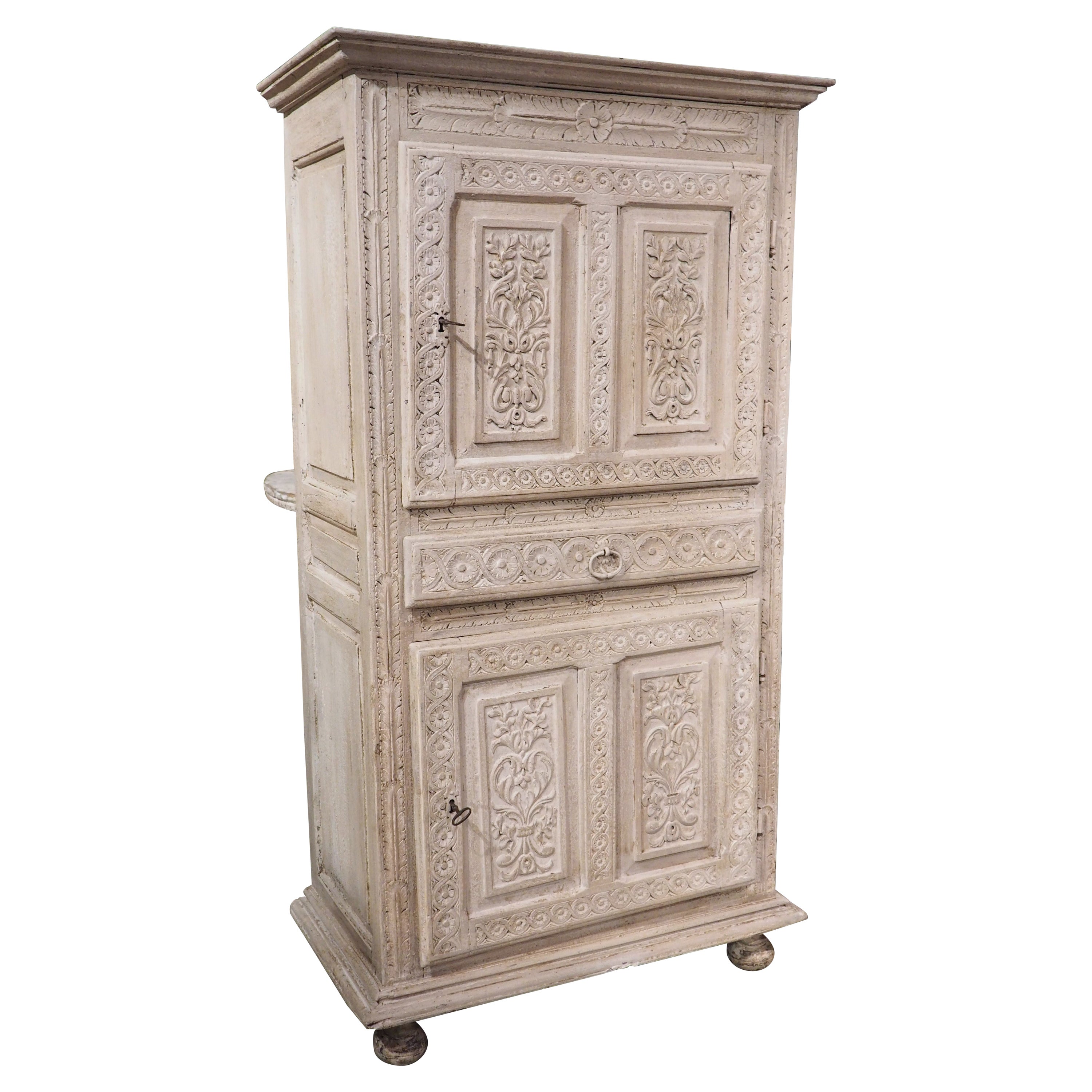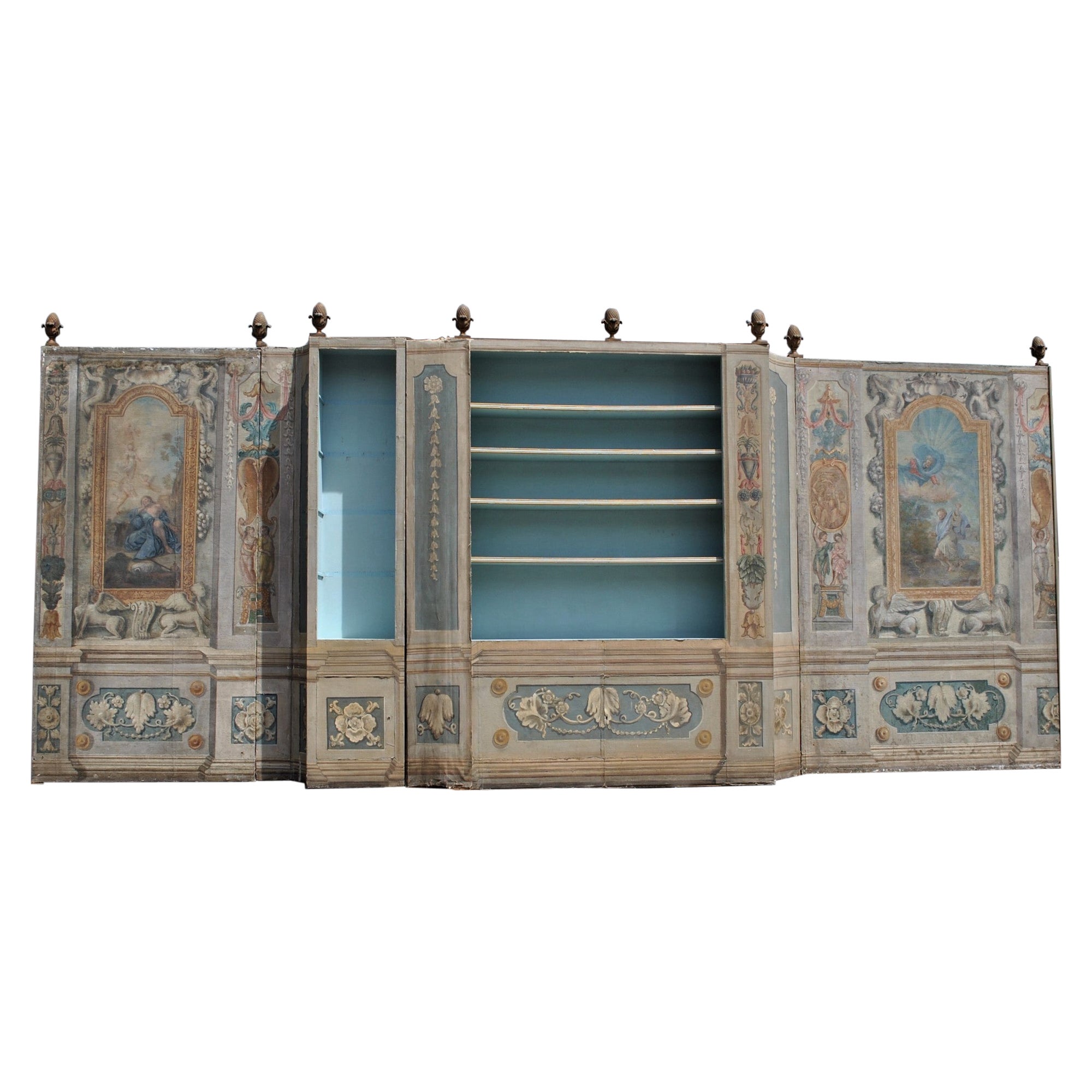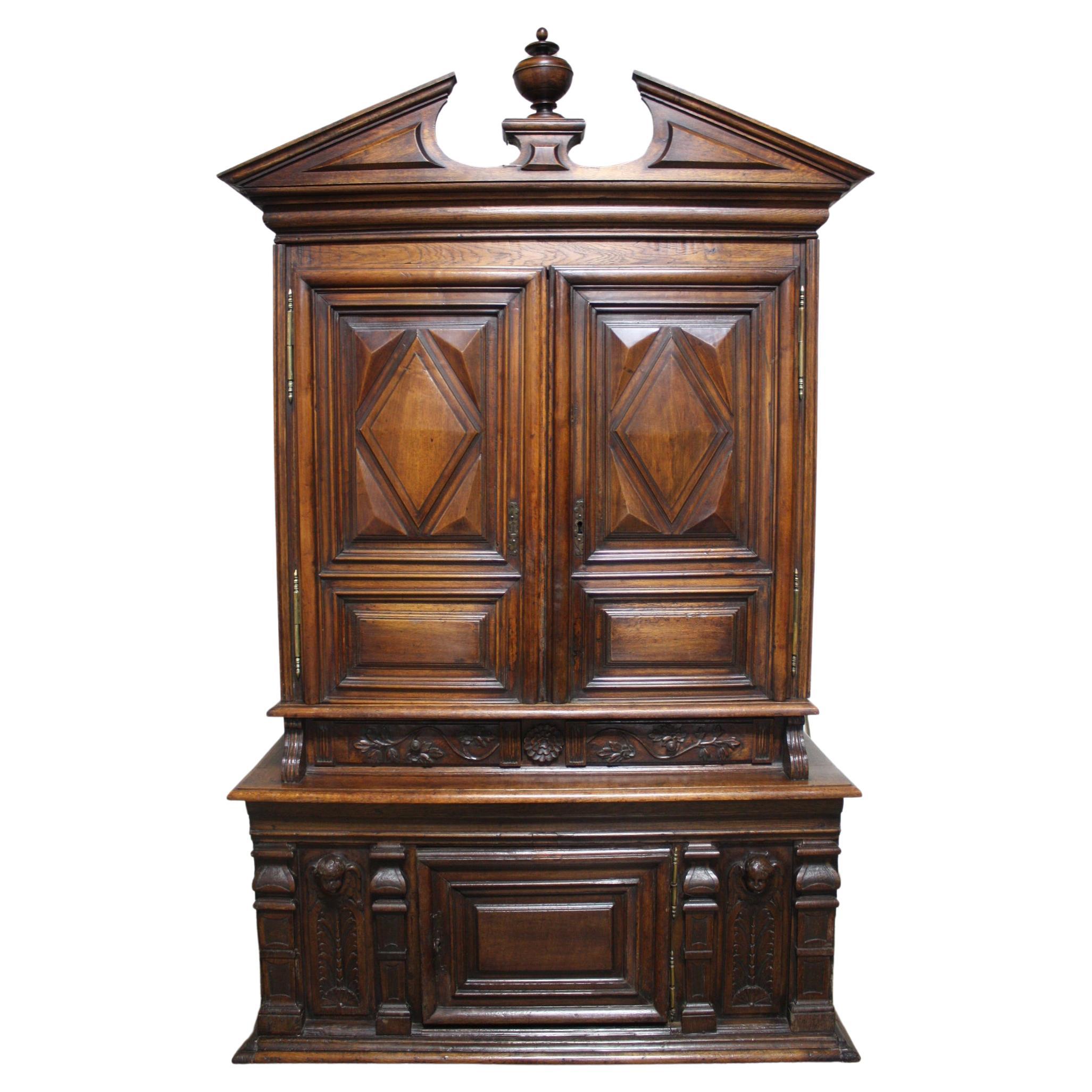Items Similar to 17th Century Antwerp Cabinet with Painted Panels Attributed to H. Van Balen
Want more images or videos?
Request additional images or videos from the seller
1 of 15
17th Century Antwerp Cabinet with Painted Panels Attributed to H. Van Balen
About the Item
This precious cabinet is one of the rare emblematic works of the city of Antwerp, produced in 17th century thanks to the collaboration between a painter and a cabinetmaker, and intended to adorn Kunstkammer (private museums) or art cabinets.
Our cabinet is decorated with 13 oil painted panels featuring mythological and allegorical subjects and perfectly reflects the Antwerp pictorial trend of the early 17th century. Definitely in the spirit of the times, where one of the roles of the kunstkammer (the room for which it is intended) is to be able to contemplate the world in all its aspects.
It opens with two doors revealing 10 drawers, 9 of which have painted panels on the front, a central door and an upper compartment, the interior of which is also decorated with a painted panel.
The left door depicts a subject from Roman mythology: Pomona and Vertumnus in the garden. The fruits and vegetables placed at the feet of Pomona evoke the allegory of summer and the abundance of nature.
While on the right door, under the airs of Venus and Love placed in a castle park surrounded by puttis, it is the allegory of spring which is thus depicted, the bouquets and vases of flowers are its main attributs.
The small central door displays the Allegory of Vanity, personified by a young woman holding an oil lamp from which smoke escapes (the flight of time), the putto blowing soap bubbles ( meaning the fragility of life) sits on a skull, a death's symbol.
The painted panel in the upper compartment shows the Apollo and the nine muses at Mount Parnassus.
This depiction of the world through a cabinet continues with the choice of topics used for the drawer panels which are inspired by the Metamorphosis of Ovid engraved by Antonio Tempesta. These engravings published in 1606 considerably increased the mythological pictorial repertoire and quickly became the source of inspiration for Antwerp artists.
The illustrated subjects:
Left side from top to bottom:
- The death of Adonis
- The death of Hyacinth
- Meleager and Atalnatan killing the wild boar
- The rape of Caenis
Right side from top to bottom:
- Hippomenes winning the race with Atalanta
- Meleager Offering Atalanta the Head of the Boar
- Procris giving Cephalus a dog and a javelin
- Pan chasing Syrynx
The central drawer: Glaucus seduced by Scylla
The stories in "The Metamorphoses" were perfectly suited subjects for cabinets of curiosities whose function was to reflect and explain the world and its origins.
An almost identical cabinet, also attributed to Hendrick Van Balen with all similar painted panels, was sold at Christie's London, December 8, 2011, lot no 107. See also another cabinet attributed to Hendrick Van Balen, sold at Christie's London 27 / 10/2015, lot 226, some panels of which are very similar to ours (the allegory of Vanity, Glaucos seduced by Scylla, Pomona and Vertumnus).
The Philadelphia Museum of Art exhibits a serie of small cabinet panels by Hendrick Van Balen, two of which have the same subject and are similar to our panels.
In addition to the fabulous painted decoration, our cabinet is executed with refinement. It has a sober but polished exterior in ebonized wood veneer and embellished with wavy molding frames. Inside, false painted tortoiseshell is used to increase the richness of the whole piece, which is particularly evidenced by two half-columns applied on the central door and the drawer above with a gallery of gilt balusters. Once opened, the little door reveals a theater designed by alternating mirrors and half-columns adorned with gilt bronze rings and the floor made up of black and white painted wood rectangles.
Following the classic design, it has a large frieze drawer and ball feet.
Our cabinet is set on a very elegant 19th century ebonized stand, composed of two beautiful columns and two half-columns, decorated with capitals, rings and bases in gilt bronze.
Dimensions including the stand: height: 64.96 in, width: 38.18 in, depth: 17.71 in.
With the doors and top compartment open, height attains: 78.74 inches, width attains 68.9.
Dimensions of the cabinet only (without stand): height: 30.70 in, width: 37.40 in, depth: 16.92 in.
Very good original condition, original hinges, locks.
The painted panels have preserved all the freshness of their original colors.
Antwerp, circa 1630, panels attributed to Hendrick Van Balen and his workshop.
In the 17th century, Antwerp was the first European center for cabinets with painted panels. The illustrations of contemporary interiors show that it was the display furniture, often in ebony veneer on the outside which when opened amazed by the richness of their small oil paintings. These cabinets were intended to store collections of jewelry, silver, minerals, shells and other specimens, in connection with the princely tradition of the kunstkammer.
Definitely works of art thanks to their decor, the painted panel cabinets have suffered dismantling and destruction over the decades due to the richness of their interiors, and few have reached us intact and complete.
The cabinet we're offering here complete and displaying all 13 original panels, remarkable for their quality and the magnificent colour palette, is all the more rare because of its mythological and allegorical subjects, unlike many others more frequently depicting religious scenes. Regarding early 17th century Antwerp school paintings, it is very difficult to find on the art market such subjects as Pomona and Vertumnus, or Allegory of Spring.
Hendrick van Balen I (1573-1632) was a master of the Antwerp Guild of St. Luke and ran his own workshop for thirty years, counting Anthony van Dyck as one of his pupils. Although he began his career painting large-scale altarpieces, Van Balen is best known for his pictures on cabinets. In keeping with the popular taste of the time, mythological scenes frequently occur on his small-scale paintings and often feature imagery from Ovid's Metamorphoses.
- Attributed to:Jan van Balen (Painter)
- Dimensions:Height: 64.96 in (165 cm)Width: 38.19 in (97.01 cm)Depth: 17.72 in (45.01 cm)
- Style:Louis XIII (Of the Period)
- Materials and Techniques:
- Place of Origin:
- Period:Early 17th Century
- Date of Manufacture:circa 1630
- Condition:Wear consistent with age and use.
- Seller Location:PARIS, FR
- Reference Number:1stDibs: LU8168233432912
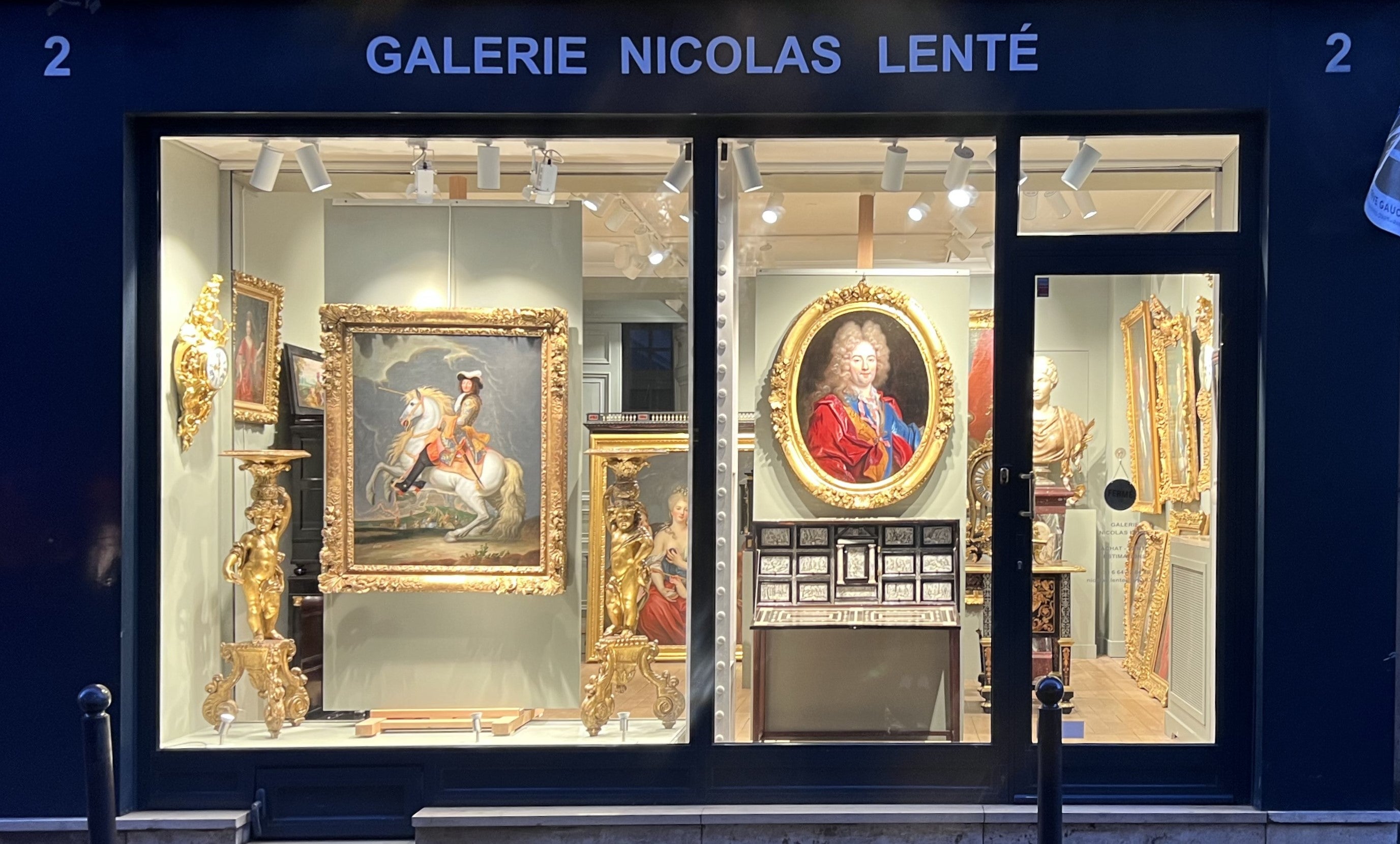
About the Seller
No Reviews Yet
Vetted Seller
These experienced sellers undergo a comprehensive evaluation by our team of in-house experts.
Established in 2011
1stDibs seller since 2023
- ShippingRetrieving quote...Ships From: PARIS, France
- Return PolicyA return for this item may be initiated within 3 days of delivery.
More From This SellerView All
- Late 17th Century French Gilt Bronze Figure of Venus on Boulle PedestalLocated in PARIS, FRLate 17th century French Gilt Bronze Figure of a Crouching Venus Gilt bronze crouching Venus on a pedestal decorated with Boulle marquetry and...Category
Antique Late 17th Century French Louis XIV Figurative Sculptures
MaterialsBronze
- The Infant St John the Baptist, a 17th Century Sevillian school Spanish BaroqueLocated in PARIS, FRThe Infant St John the Baptist, A first half of 17th century Sevillian School Cercle of Juan de Mesa Velasco (Córdoba, 1583 - Séville, 1627) Polychrome and carved wood Height: 65 cm ...Category
Antique Early 17th Century Spanish Baroque Figurative Sculptures
MaterialsWood
- A 16th Century Renaissance Cavred Walnut Buffet Loire ValleyLocated in PARIS, FRA 16th Century French Renaissance Cavred Walnut Buffet Loire Valley Dimensions: H. 1m62; L. 1m02; P. 0.52m. (63.78 in. x 40.16 in x 20....Category
Antique 16th Century French Cupboards
MaterialsWalnut
- French 18th Century Regence Ormolu-Mounted Commode by Etienne DoiratBy Etienne DoiratLocated in PARIS, FRA Regence ormolu-mounted commode by Etienne Doirat (Paris, 1675-1732) Rare and elegant commode curved on the front and on the sides, in amaranth veneer arranged in sheets in the frames. It opens with four drawers in three rows: two large and two short and asymmetrical . Rich ornamentation of chiseled and gilt bronzes: the Rococo frontal cartouche, mounts with oak leaf windings, foliated handles and clogs, rosettes on the sides. Flanders red marble top. Size: h. 35.04 inch, w. 56.69 inch, d. 33.46 inch By Etienne Doirat (1675-25 June 1732), Regency period, 18th century Although not stamped, our commode belongs by its shape and its bronze ornamentations to an identified corpus of the production of Etienne Doirat, one of the most talented cabinetmakers under the Regency. This group of chests of drawers listed in public and private collections, some of which stamped E. Doirat are characterized by the almost identical front cartouche. On our chest of drawers, this cartouche is formed by two scalloped lambrequins joined by a clip they are extended by branches with acanthus foliage and flowers with beaded friezes. Inside are two keyholes, the first with a lion's mouth, the second formed by two stylized dolphins facing each other with lion's paws under a valance. Chests of drawers by Etienne Doirat with the frontal cartouche: Commode in identical "tombeau" shape: - Commode stamped Doirat, Christie's London, July 10, 2008 lot n 43 - Unstamped chest of drawers, doc. Me Tajan, published in "French 18th century Furniture" by Kjelleberg Commode of different shape, identical front cartouche: - Chest of drawers with three drawers, stamped Doirat, Christie's London, November 27, 2018 lot n 509 - Sarcophagus chest of drawers, stamped Doirat, J. Paul Getty museum, Los Angeles - Chest of drawers with two drawers, stamped Doirat, private collection, illustrated in J. - D. Augarde - Chest of drawers with three drawers, stamped by Migeon, but attributed to Doirat from the former Eugène Kraemer collection, sale at Galerie Georges Petit (Paris), May 5-6, 1913, lot 141; former Ogden Mills collection, Paris, rue de Varenne...Category
Antique Early 18th Century French Régence Commodes and Chests of Drawers
MaterialsMarble, Bronze
- Italian 19th century pair of very tall decorative marble obelisksLocated in PARIS, FRMonumental pair of obelisks veneered with following marbles: pink marble of the Pyrenees, blue Turquin and yellow of Siena. A very decorative pair of tall obelisks that would look g...Category
Antique Late 19th Century Italian Neoclassical Pedestals and Columns
MaterialsMarble, Siena Marble
- Early 18th Century Italian Carved Giltwood Mirror Depicting Four SeasonsLocated in PARIS, FREarly 18th century richly and profusely carved giltwood mirror depicting personnified allegories of the four seasons. The giltwood frame is made of adjourned wood decorated with flowers and leaves forming acanthus leaves spandrels. The pediment is lavishly carved and adorned with scrolls, foliage and flowers. Four putti...Category
Antique Early 18th Century Italian Louis XIV Wall Mirrors
MaterialsGiltwood
You May Also Like
- Flemish Cabinet Antwerp 17th CenturyBy Europa AntiquesLocated in Madrid, ESFlemish Cabinet Antwerp 17th Century It has ten drawers underlined with guilloché moldings and adorned with small turned knobs. It is decorate...Category
Antique Late 17th Century Belgian Renaissance Cabinets
MaterialsTortoise Shell, Wood
- Important Antwerp Cabinet In Tortoiseshell, Ebony And Bronze, 17th CenturyLocated in Honnelles, WHTImportant Antwerp Cabinet In tortoiseshell, ebony And Bronze, theater in ebony and bone marquetryCategory
Antique 17th Century Belgian Louis XIII Cabinets
MaterialsBronze
- Rare 17th Century Baroque Ebony with Silver Cabinet, Antwerp, WunderkammerLocated in AMSTERDAM, NHAntwerp Mid 17th century An Antwerp ebony, silver foil, gilded bronze, and with a mirror: jewelry cabinet. With a secret compartment in the slide top. The cabinet is inlaid with fi...Category
Antique Mid-17th Century Belgian Baroque Cabinets
MaterialsSilver, Brass
- 17th Century Painted Oak Homme Debout Cabinet from Southwest FranceLocated in Dallas, TXA Homme debout is a two-bodied cabinet with a drawer separating the sections. This handsome Homme debout from southwest France was hand carved from oak in the 1600s. The period Louis...Category
Antique 17th Century French Louis XIII Cabinets
MaterialsWood, Paint
- Pair of Bookcases with Painted Panels from the 17th CenturyLocated in MARSEILLE, FRSet of 2 bookcases made in the 1950s/60s by an antique dealer in Turin, composed of 20th century elements (bookcases), covered with canvases painted...Category
Antique 17th Century Italian Louis XIV Cabinets
MaterialsCanvas, Fruitwood
- French 17th Century CabinetLocated in Stockbridge, GAWhat a wonderful piece, full of character with the ornaments at the base and the putties carved in the wood.Category
Antique Late 17th Century French Renaissance Cabinets
MaterialsOak, Walnut
Recently Viewed
View AllMore Ways To Browse
Jewelry Display Cases Used
Used Jewellery Display Cases
Jewelry Display Case Used
Wood Vaneer
Antique Paint Palette
17th Panel
17th Century Panel
Large Cabinet Louis
Antique Black Paint Color
Louis Small Cabinet
Antique White Colour Paint
Antique White Paint Colour
Paint Color Antique White
Antique H Hinges
Kitchen Antique White Paint
Museum Storage
Antique White Cabinet Paint
Antique White Painted Cabinets

